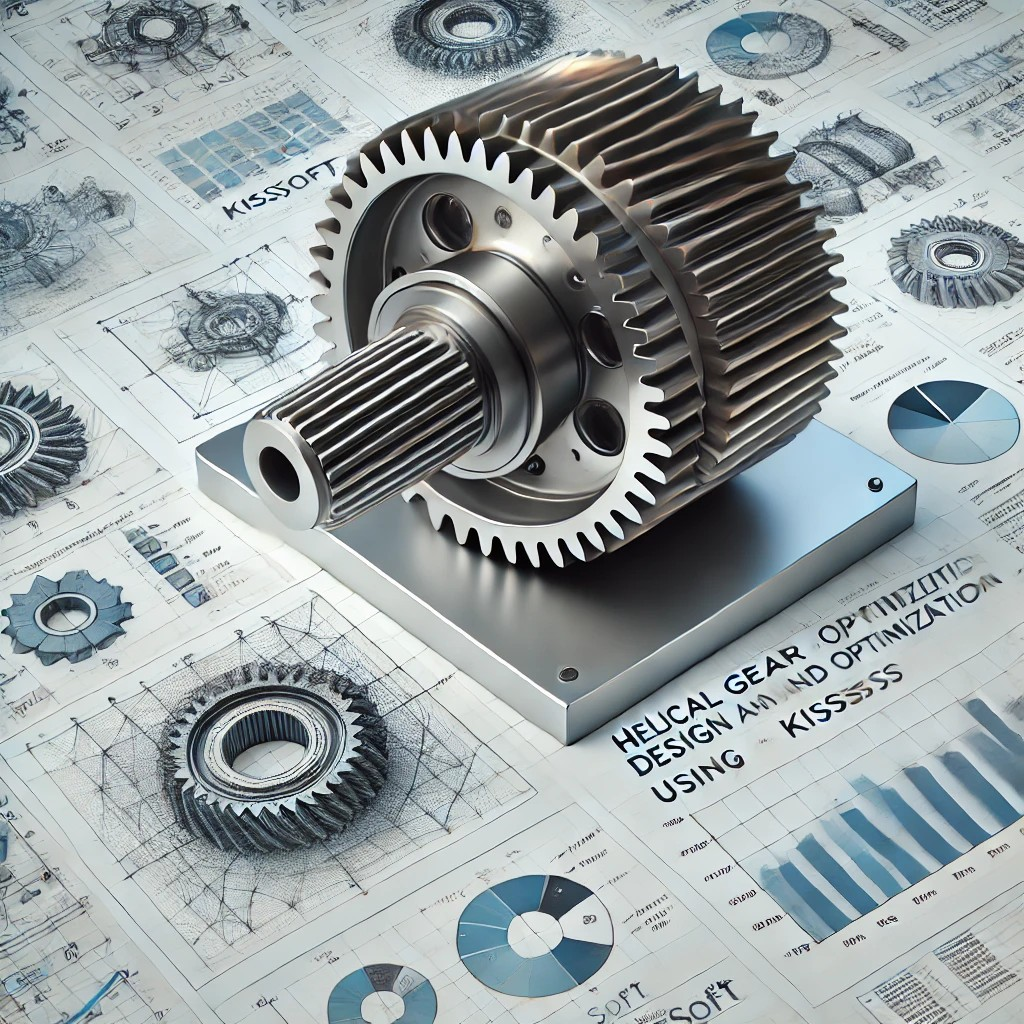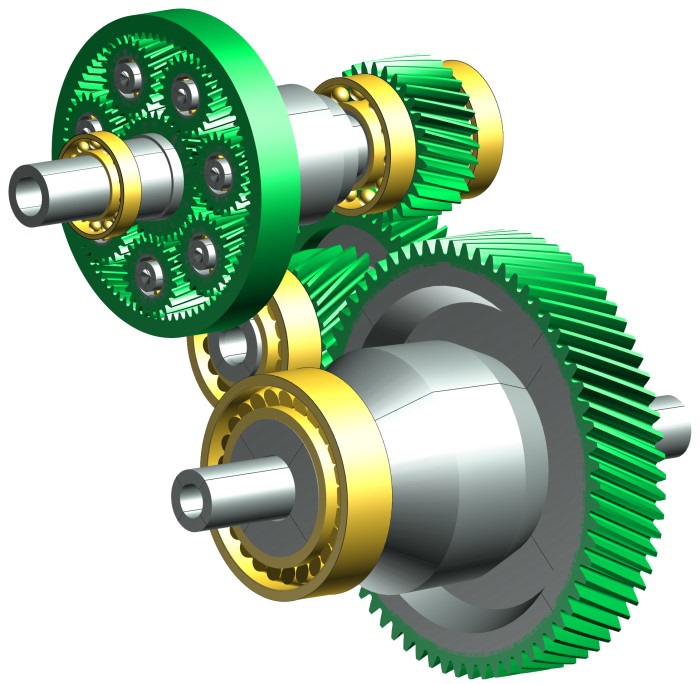Helical Gear Design and Optimization Using KISSsoft: A Comprehensive Guide
 Vishal Sharma
Vishal Sharma
Helical gears are among the most widely used types of gears due to their superior load-bearing capacity, smoother transmission, and efficiency. These gears are employed in various applications, from automotive gearboxes to industrial machinery. This blog post dives into the design and optimization of helical gears using KISSsoft, one of the leading tools in gear engineering.

Understanding Helical Gears
Helical gears have teeth that are cut at an angle to the gear axis, forming a helix. This design results in gradual engagement between teeth, which leads to smoother operation and reduced noise compared to spur gears. The benefits of helical gears include:
High Load Capacity: Due to the larger contact ratio, helical gears can handle more load.
Smoother Operation: The angled teeth engage gradually, reducing shocks and vibrations.
Versatility: They are widely used in parallel or crossed shaft applications.
However, helical gears also generate axial thrust and require careful design to ensure optimal performance and longevity.
Gear Design Fundamentals
Before diving into the optimization process, it’s essential to understand the basic parameters that define a helical gear:
Module: Represents the size of the gear teeth.
Number of Teeth: Determines the gear ratio and is vital for the correct meshing of gears.
Helix Angle: The angle of the gear teeth relative to the gear axis. Higher helix angles result in smoother meshing but generate more axial thrust.
Pressure Angle: The angle at which the teeth exert force. Typically, 20° is standard.
Face Width: The width of the gear teeth. Increasing the face width can enhance strength but also adds weight and cost.

Why Use KISSsoft for Gear Design?
KISSsoft is an industry-standard software for gear design and optimization. It supports various gear types, including spur, helical, bevel, and worm gears, and helps engineers perform calculations based on international standards such as ISO 6336. The tool offers modules for rough sizing, fine sizing, and optimization, allowing engineers to iterate quickly and refine gear design for specific requirements.

Step-by-Step Guide to Helical Gear Design in KISSsoft
1. Input Initial Parameters
Open KISSsoft and select the Helical Gear module.
Input the basic gear data:
Module: Based on the desired strength and size of the gear.
Number of Teeth: Input the number of teeth for both the pinion and the gear.
Helix Angle: Typically between 15° to 30° for most applications. The helix angle impacts noise, smoothness, and thrust load.
Face Width: Enter the face width based on application load requirements.
2. Material Selection
Choose the material for the gears, such as steel, cast iron, or a custom material. The material properties (like strength, hardness, and fatigue limit) significantly impact the gear’s performance.
KISSsoft provides a database of standard materials or allows custom material inputs based on project specifications.
3. Perform Calculations
Once the initial data is set, KISSsoft performs a range of calculations:
Contact Stress: Determines the surface pressure between gear teeth.
Bending Stress: Calculates the force acting on the root of the gear teeth.
Safety Factors: Evaluates the safety against tooth breakage and pitting.
Efficiency: Calculates the mechanical efficiency of the gear set.
4. Load Spectrum Analysis
For gears subjected to variable loads, the Load Spectrum module in KISSsoft allows you to input load cases. This feature is especially valuable in industries like automotive, where gears experience fluctuating forces.
KISSsoft can simulate the gear’s performance under different load conditions, which helps in understanding wear patterns, longevity, and fatigue resistance.
5. Fine Sizing and Optimization
After running the initial calculations, KISSsoft’s Fine Sizing tool can adjust parameters like tooth profile, helix angle, and root fillet to optimize the gear.
The Optimization module iteratively adjusts variables to minimize material usage, reduce stress, and enhance performance. Some key optimization techniques include:
Minimizing Mass: Adjusting face width and tooth dimensions to reduce weight without sacrificing performance.
Improving Contact Pattern: Refining the gear geometry to ensure a smooth contact pattern, which improves efficiency and reduces noise.
Maximizing Durability: Ensuring the gear can handle operational loads over its intended lifespan.
6. Heat Treatment and Surface Finish
Once the gear dimensions are optimized, the final step is to define the heat treatment and surface finish. Surface treatments such as carburizing or nitriding can improve wear resistance and extend the gear's operational life.
KISSsoft can simulate the effect of heat treatment processes on the material properties, which further refines the gear design.
Case Study: Helical Gear Design Using KISSsoft
Let’s consider an example of designing a helical gear for an electric vehicle (EV) differential. The requirements include high torque transmission, minimal noise, and durability for the vehicle's lifespan.
Input Parameters:
Module: 2.5 mm
Number of Teeth: 35 (pinion) and 85 (gear)
Helix Angle: 20°
Face Width: 30 mm
Material: 18CrNiMo7-6 steel, case-hardened
Using KISSsoft, we performed the following steps:
Initial Sizing: The rough sizing tool calculated the initial dimensions, ensuring that the gear pair met the required gear ratio.
Load Simulation: The load spectrum module simulated the differential’s torque distribution during various driving conditions.
Optimization: Through fine sizing, the helix angle was adjusted slightly to 22°, reducing axial thrust while maintaining smooth transmission.
Surface Treatment: Carburizing was applied to the gear surface to improve wear resistance, which extended the gear’s estimated life by 15%.
Results:
Contact Stress: Reduced by 10% compared to the initial design.
Efficiency: Increased by 5% due to the optimized contact pattern.
Weight Reduction: A slight reduction in face width helped minimize weight by 8% without compromising strength.
Benefits of Using KISSsoft for Helical Gear Design
Time Efficiency: The automated calculations and iterative optimization tools help reduce the design cycle significantly.
Accuracy: KISSsoft uses industry-standard formulas and considers real-world factors like material fatigue and wear.
Customization: The software allows for the integration of custom materials, load spectra, and specific client requirements, making it ideal for specialized applications.
Conclusion
Helical gear design is a complex task that requires careful consideration of multiple parameters like load, efficiency, noise, and durability. KISSsoft streamlines this process by providing powerful calculation tools and optimization modules, ensuring that gears are designed to the highest standards of performance and reliability. By leveraging its advanced capabilities, engineers can achieve cost-efficient, durable, and high-performance gear solutions tailored to their specific applications.
Whether you're working on automotive gearboxes, industrial machinery, or aerospace applications, KISSsoft offers an all-in-one solution for optimizing helical gear designs.

Subscribe to my newsletter
Read articles from Vishal Sharma directly inside your inbox. Subscribe to the newsletter, and don't miss out.
Written by

Vishal Sharma
Vishal Sharma
I hold a Master's degree in Mechanical Design from BITS Pilani, a prestigious institution renowned for engineering. Over the years, my journey has taken me through various pivotal roles that enriched my technical expertise and broadened my perspective on the industry. I started with New Product Development, delving deep into the intricate nuances of product creation from scratch. As an FEA engineer, I had the privilege to leverage software tools like Ansys and Hypermesh, allowing me to comprehend the depths of Finite Element Analysis and Computational Fluid Dynamics. Beyond these roles, my passion for teaching led me to become an Associate Instructor at Skill Vertex, and since 2018, I've been actively educating a growing audience on YouTube. My proficiency doesn't just lie in theoretical knowledge but extends to practical software skills as well, with hands-on experience in CATIA, SolidWorks, and Tolerance Stack-Up Analysis. One of my notable achievements includes the research and design of differential assembly and driveline components, which was a testament to my dedication and knack for mechanical designing. But at the core of it all, my true desire is to share. I want to bridge the gap between academia and industry by spreading professional knowledge on FEA, 3D modeling software, and tolerance stack-up analysis. I believe in empowering the next generation of engineers with not just knowledge but the wisdom of experience.